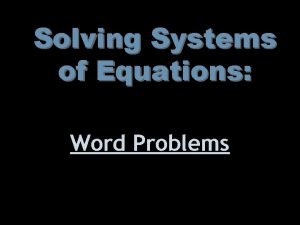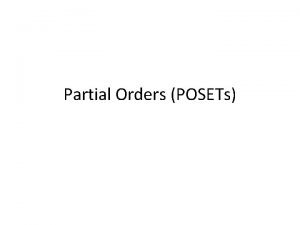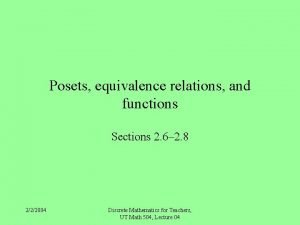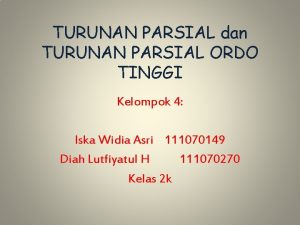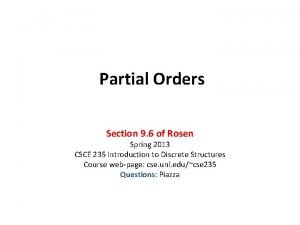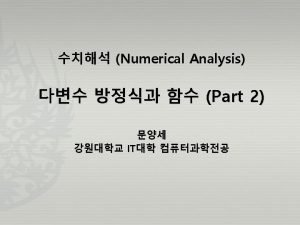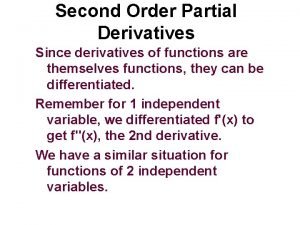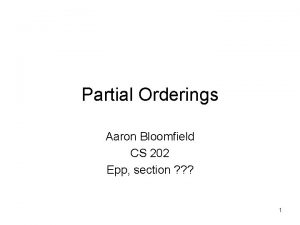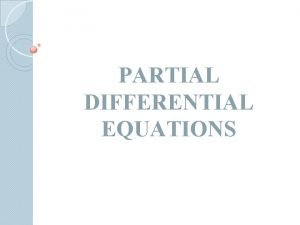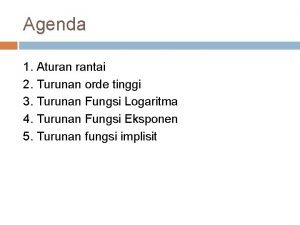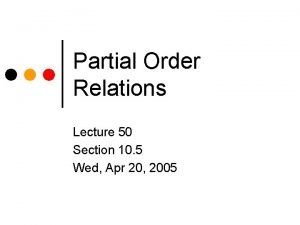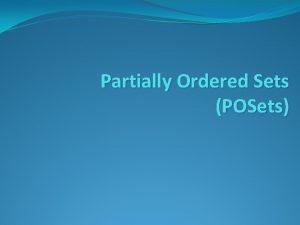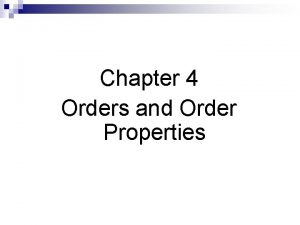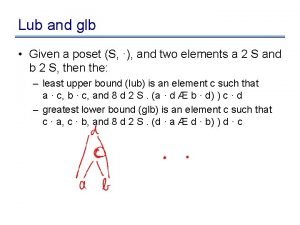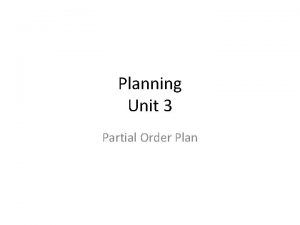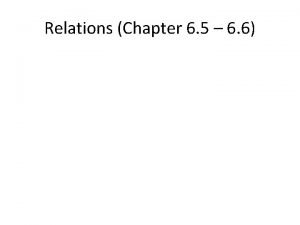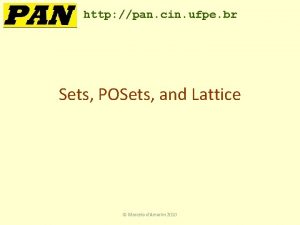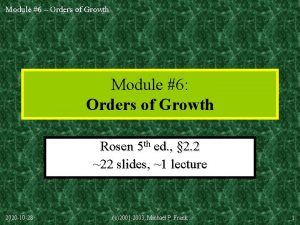Partial Orders POSETs Partial order or POSET Definitions
























- Slides: 24

Partial Orders (POSETs)

Partial order or POSET • Definitions: – A relation R on a set A is called a partial order if it is • Reflexive • Antisymmetric • Transitive – set A together with a partial ordering R is called a partially ordered set (poset, for short) and is denote by [A; R] • A is partially ordered by the relation R Week Partial Order If a transitive relation is irreflexive and asymmetric (a strong partial order),


Example – The relation “less than or equal to” over the set of integers (Z; ) since for every a, b Z, it must be the case that a b or b a – is a Poset • What happens if we replace with <? • Is < Poset? • The relation < is not reflexive, and (Z, <) is not a poset

Total Order

Poset or Hasse Diagrams • Like relations and functions, partial orders have a convenient graphical representation: Hasse Diagrams – Consider the digraph representation of a partial order – Because we are dealing with a partial order, we know that the relation must be reflexive and transitive – Thus, we can simplify the graph as follows • Remove all self loops • Remove all transitive edges • Remove directions on edges assuming that they are oriented upwards – The resulting diagram is far simpler

Hasse Diagram: Example a 5 a 4 a 2 a 3 a 1

Hasse Diagrams: Example (1) • Of course, you need not always start with the complete relation in the partial order and then trim everything. • Rather, you can build a Hasse Diagram directly from the partial order • Example: Draw the Hasse Diagram for the following partial ordering: {(a, b) | a|b } on the set {1, 2, 3, 4, 5, 6, 10, 12, 15, 20, 30, 60}

Hasse Diagram: Example (2) 60 20 12 6 4 2 30 15 10 3 1 5

Least & Greatest Elements • An element b B is called the least element of B if b < x for all x B. The set B can have at most one least element. For if b and b’ were two least elements of B, then we would have b < b' and b' < b. • Hence, by antisymmetry b = b‘. • An element b B is called the greatest element of B if x < b for all x B. The set B can have at most one greatest element.

Least & Greatest Elements • A= {2, 6, 3, 8, 15, 27} • Then least element is 2 and greatest element is 27

Lower and Upper bounds • An element b A is called a lower bound of B if b ≤ x for all x B. • An element b A is called a upper bound of B if b ≥ x for all x B. • If the set of lower bounds of B has a greatest element then this element is called the greatest lower bound (or glb) of B; • similarly, if the set of upper bounds of B has a least element then this element is called the least upper bound (or lub) of B.

Examples • The lower bounds of S = {{a, b, c}, {b, c}} are • {b}, {c}, {b, c} and ∅. There are no others. • Of the lower bounds of S, greatest lower bound is • {b, c} • In general, when A, B are sets, – glb {A, B} = A ∩ B

Examples • Within the poset P{a, b, c}, the upper bounds of S = {{a}, {b}} are • {a, b} and {a, b, c}. • Of the upper bounds of S, the least upper bound is • {a, b} • In general, when A, B are sets, • lub = {A, B} = A ∪ B

Extremal Elements: Example 1 Give lower/upper bounds & glb/lub of the sets: {d, e, f}, {a, c} and {b, d} g a CSCE 235, Spring 2010 • Lower bounds: , thus no glb • Upper bounds: , thus no lub {a, c} h d {d, e, f} i e b f c • Lower bounds: , thus no glb • Upper bounds: {h}, lub: h {b, d} • Lower bounds: {b}, glb: b • Upper bounds: {d, g}, lub: d because dpg Partial Orders 15

Extremal Elements: Example 2 i f j g h • Lower bounds: {a, c}, thus glb is c • Upper bounds: {e, f, g, h, i, j}, thus lub is e e b c a • Bounds, glb, lub of {c, e}? d • Bounds, glb, lub of {b, i}? • Lower bounds: {a}, thus glb is c • Upper bounds: , thus lub DNE


Poset Diagrams

Poset Diagrams

Lattice • A lattice is a poset in which each pair of elements has a least upper bound a greatest lower bound.

Lattices: Example 1 • Is the example from before a lattice? • No, because the pair {b, c} does not have a least upper bound i f j g h e b c a d

Lattices: Example 2 • What if we modified it as shown here? • Yes, because for any pair, there is an lub & a glb j i f g h e b c a d

A Lattice Or Not a Lattice? • To show that a partial order is not a lattice, it suffices to find a pair that does not have an lub or a glb (i. e. , a counter-example) • For a pair not to have an lub/glb, the elements of the pair must first be incomparable (Why? ) • You can then view the upper/lower bounds on a pair as a sub-Hasse diagram: If there is no minimum element in this sub-diagram, then it is not a lattice

 Poset matematika diskrit
Poset matematika diskrit Casey orders 3 pizzas
Casey orders 3 pizzas Casey orders 3 pizzas
Casey orders 3 pizzas Casey orders 3 pizzas and 2 orders of breadsticks
Casey orders 3 pizzas and 2 orders of breadsticks Via optica
Via optica Poşet teslim tutanak formu
Poşet teslim tutanak formu Define poset with example
Define poset with example Contoh soal diagram hasse
Contoh soal diagram hasse Poset discrete math
Poset discrete math Define poset with example
Define poset with example Greatest lower bound and least upper bound
Greatest lower bound and least upper bound Poset reticulado
Poset reticulado S düzeni kitapçık dağıtımı
S düzeni kitapçık dağıtımı Lattice poset
Lattice poset Bina sınav komisyonu poşet teslim tutanak formu
Bina sınav komisyonu poşet teslim tutanak formu Contoh turunan parsial pertama
Contoh turunan parsial pertama Minimum and maximum
Minimum and maximum Second order partial derivative
Second order partial derivative Anti symmetric relation
Anti symmetric relation Partial differentiation
Partial differentiation Lexicographical meaning
Lexicographical meaning Hyperbolic partial differential equation
Hyperbolic partial differential equation Dynamic partial order reduction
Dynamic partial order reduction Contoh soal aturan rantai
Contoh soal aturan rantai Partial order relation
Partial order relation



